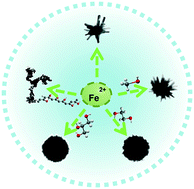Alcohol-assisted self-assembled 3D hierarchical iron (hydr)oxide nanostructures for water treatment
Abstract
Three-dimensional (3D) iron (hydr)oxides have attracted much attention due to their excellent adsorption, catalytic capacities and environmentally benign nature. To further understand their formation mechanism, self-assembled 3D hierarchical iron (hydr)oxides are synthesized with different alcohol additives: methanol, ethylene glycol (EG), glycerol and polyvinyl alcohol (PVA). In pure water or with the existence of small molecule alcohols, the resulting products are urchin-like α-FeOOH consisting of nanorods. Moreover, the samples with EG and glycerol addition have a well-ordered hairy surface, while the sample with methanol addition has an unordered dull surface. Due to their higher surface charges, the samples obtained with EG and glycerol have a lower agglomeration degree and higher specific surface area (139.99 m2 g−1 and 119.05 m2 g−1, respectively). Under the existence of polymer PVA, the resulting product is α-Fe2O3 with a chain structure consisting of nanosheets. The urchin-like α-FeOOH with an ordered hairy surface has better performance in chloramphenicol removal by both adsorption and heterogeneous Fenton reaction under visible light than the other samples. The results reflect the potential advantages of hierarchically assembled 3D nanostructures for application in water treatment.

- This article is part of the themed collection: Crystalline Materials for Environmental Remediation


 Please wait while we load your content...
Please wait while we load your content...